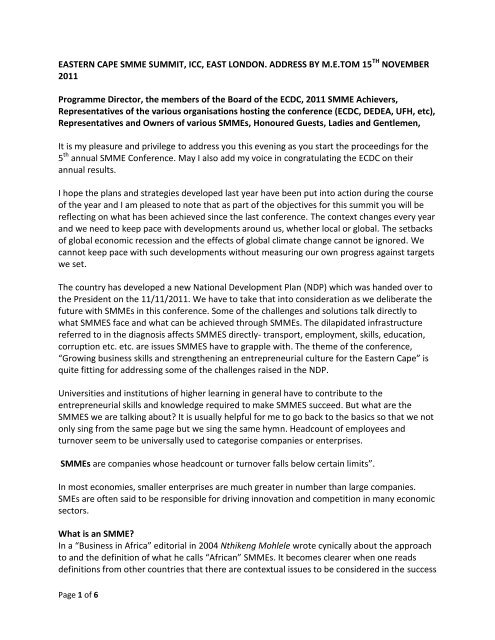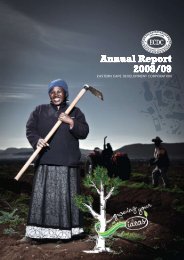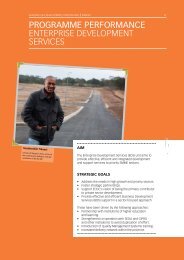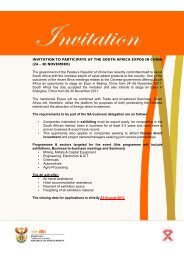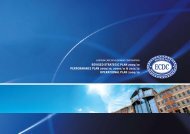EASTERN CAPE SMME SUMMIT, ICC, EAST LONDON. ADDRESS ...
EASTERN CAPE SMME SUMMIT, ICC, EAST LONDON. ADDRESS ...
EASTERN CAPE SMME SUMMIT, ICC, EAST LONDON. ADDRESS ...
You also want an ePaper? Increase the reach of your titles
YUMPU automatically turns print PDFs into web optimized ePapers that Google loves.
<strong><strong>EAST</strong>ERN</strong> <strong>CAPE</strong> <strong>SMME</strong> <strong>SUMMIT</strong>, <strong>ICC</strong>, <strong>EAST</strong> <strong>LONDON</strong>. <strong>ADDRESS</strong> BY M.E.TOM 15 TH NOVEMBER<br />
2011<br />
Programme Director, the members of the Board of the ECDC, 2011 <strong>SMME</strong> Achievers,<br />
Representatives of the various organisations hosting the conference (ECDC, DEDEA, UFH, etc),<br />
Representatives and Owners of various <strong>SMME</strong>s, Honoured Guests, Ladies and Gentlemen,<br />
It is my pleasure and privilege to address you this evening as you start the proceedings for the<br />
5 th annual <strong>SMME</strong> Conference. May I also add my voice in congratulating the ECDC on their<br />
annual results.<br />
I hope the plans and strategies developed last year have been put into action during the course<br />
of the year and I am pleased to note that as part of the objectives for this summit you will be<br />
reflecting on what has been achieved since the last conference. The context changes every year<br />
and we need to keep pace with developments around us, whether local or global. The setbacks<br />
of global economic recession and the effects of global climate change cannot be ignored. We<br />
cannot keep pace with such developments without measuring our own progress against targets<br />
we set.<br />
The country has developed a new National Development Plan (NDP) which was handed over to<br />
the President on the 11/11/2011. We have to take that into consideration as we deliberate the<br />
future with <strong>SMME</strong>s in this conference. Some of the challenges and solutions talk directly to<br />
what <strong>SMME</strong>S face and what can be achieved through <strong>SMME</strong>s. The dilapidated infrastructure<br />
referred to in the diagnosis affects <strong>SMME</strong>S directly- transport, employment, skills, education,<br />
corruption etc. etc. are issues <strong>SMME</strong>S have to grapple with. The theme of the conference,<br />
“Growing business skills and strengthening an entrepreneurial culture for the Eastern Cape” is<br />
quite fitting for addressing some of the challenges raised in the NDP.<br />
Universities and institutions of higher learning in general have to contribute to the<br />
entrepreneurial skills and knowledge required to make <strong>SMME</strong>S succeed. But what are the<br />
<strong>SMME</strong>S we are talking about? It is usually helpful for me to go back to the basics so that we not<br />
only sing from the same page but we sing the same hymn. Headcount of employees and<br />
turnover seem to be universally used to categorise companies or enterprises.<br />
<strong>SMME</strong>s are companies whose headcount or turnover falls below certain limits”.<br />
In most economies, smaller enterprises are much greater in number than large companies.<br />
SMEs are often said to be responsible for driving innovation and competition in many economic<br />
sectors.<br />
What is an <strong>SMME</strong>?<br />
In a “Business in Africa” editorial in 2004 Nthikeng Mohlele wrote cynically about the approach<br />
to and the definition of what he calls “African” <strong>SMME</strong>s. It becomes clearer when one reads<br />
definitions from other countries that there are contextual issues to be considered in the success<br />
Page 1 of 6
or failure, and the definition of <strong>SMME</strong>s or SMEs. But let us hear what Nthikeng says first, and I<br />
quote him at length:<br />
“The African business graveyard is littered with corpses of small and medium scale businesses<br />
that would have survived if anyone took notice. Governments, bankers, policy makers, even the<br />
World Bank institutions all agree that small businesses are the engine of growth in any<br />
economy.<br />
The key to unlock this vast potential wealth of Africa and create sustainable prosperity is<br />
however missing. The men and women in designer suits who regularly boast at conferences<br />
about their programmes for small business are mere imposters. If they had workable clues on<br />
how to assist small businesses, we would not be writing this editorial.<br />
It would seem that there is no concrete and reliable definition of what African Small Medium<br />
and Micro Enterprises (<strong>SMME</strong>s) are. Current definitions primarily address this lack of definition<br />
by addressing what <strong>SMME</strong>s are not, making the definitions over dependent on contrasts.<br />
The understanding of what <strong>SMME</strong>s are is pretty much comparative jargon. <strong>SMME</strong>s are<br />
obviously not trillion dollar(s)worth of corporate multinationals. They do not have complex and<br />
specialist audited annual turnover spread sheets. Definition by references to the number of<br />
employees and total business assets also adds to confusion, of what, in laymen's terms,<br />
comprises a small business.<br />
But whatever definition one accepts, the truth is no one is truly interested or knows how to<br />
assist African small business. Without a blueprint on how to assist the African entrepreneur, the<br />
chances of greater success in this critical sector are small, at best. So who will bail the cat?<br />
Clearly the various organisations already interested in this area must first of all accept defeat.<br />
They should as a matter of urgency re-channel the millions of dollars misspent every year to<br />
identify key sectors on the continent where genuine assistance can be applied to assisting the<br />
myriads of bankable business ideas that are begging for financial and other support. Policy<br />
makers must practice what they preach”.<br />
Most definitions from the world still use the number of employees and the total business assets<br />
that Mohlele says are adding to confusion to define <strong>SMME</strong>s.<br />
There seems to be no doubt about the significant role played by <strong>SMME</strong>s in driving the economy<br />
of many countries. The linkages with communities, big business, employment creation,<br />
innovation etc are well-documented. It is indicated in one report that “The Indian Micro and<br />
Small Enterprises (MSEs) sector plays a pivotal role in the overall industrial economy of the<br />
country. It is estimated that in terms of value, the sector accounts for about 39% of the<br />
manufacturing output and around 33% of the total export of the country. Further, in recent<br />
years the MSE sector has consistently registered higher growth rate compared to the overall<br />
industrial sector. The major advantage of the sector is its employment potential at low capital<br />
cost. As per available statistics, this sector employs an estimated 31 million persons spread over<br />
Page 2 of 6
12.8 million enterprises and the labour intensity in the MSE sector is estimated to be almost 4<br />
times higher than the large enterprises.”<br />
.<br />
One of the major challenges that keeps creeping in whenever there are discussions about<br />
<strong>SMME</strong>s is their financing or lack thereof.<br />
A 2008 report by Michael Turner et al is very rich in information related to the financing<br />
challenges faced by <strong>SMME</strong>s. That report is summarized in the following section:<br />
South Africa’s lending and financial services infrastructures are more advanced than many other<br />
upper-middle-income countries. In many respects, South Africa compares favorably with<br />
developed economies, although not across all segments of society. Credit access for South<br />
African <strong>SMME</strong>s is a tale of two economies. The formal sector, or “first economy,” has relatively<br />
easy access to credit. The very large informal sector, or “second economy,” lacks such easy<br />
access. Information solutions can help bridge these two sectors of the economy and ease the<br />
transition of informal businesses to the formal sector. By putting needed data in the hands of<br />
established credit bureaus, South Africa can move the well-established credit infrastructure that<br />
“last mile” to smaller but vital businesses.<br />
South Africa has a world-class information infrastructure. Compared with other upper-middleincome<br />
nations, South Africa has a highly advanced credit information system, and the capacity<br />
and skills to address any identified credit access problems. However, the country faces<br />
significant challenges in collecting data from the large, less formal economy.<br />
Large lenders, using information solutions, can profitably lend to small, medium, and microenterprises<br />
(<strong>SMME</strong>s). It has been argued that only smaller lenders willing to make costly<br />
investments in relationship banking are able to profitably extend credit to <strong>SMME</strong>s. There is good<br />
reason to believe, however, that larger lenders, using rich data sources and information<br />
solutions, can profitably lend to <strong>SMME</strong>s.<br />
Many <strong>SMME</strong>s cannot access credit owing to lack of information. As automated underwriting<br />
becomes more common, lenders increasingly rely on standardized data when extending credit.<br />
In automated underwriting, the default assumption is that insufficient information equals high<br />
credit risk. As such, most lenders view many entrepreneurs in South Africa, particularly in the<br />
informal economy, as too risky for credit, owing, in part, to insufficient credit information.<br />
Trade credit and non-financial payment data are underused in South Africa. Economies around<br />
the world routinely collect trade credit data for commercial lending, including the formal<br />
economy in South Africa. Countries are also beginning to collect non-financial payment data<br />
(such as utility and telecom payments) when standard credit information is unavailable.<br />
However, such information is rarely collected in South Africa. Collecting more trade credit data<br />
from the informal sector could greatly expand access to credit for small and micro-enterprises.<br />
In the era of information/knowledge society and economy these limitations have to be<br />
addressed.<br />
Page 3 of 6
Universities and other institutions of higher education have to address these information gaps.<br />
Whether it is through the penetration of information technology to areas that currently do not<br />
have it or through availing the information in a manner that will assist the <strong>SMME</strong>s. The Centre<br />
of Excellence at UFH Computer Science Department is forging ahead with helping communities<br />
in deep rural areas to access the technology that assists in ensuring the ICT and IS skills are<br />
enhanced so as to close this gap. They are working with schools and communities in the Dwesa-<br />
Cwebe area, for example, to achieve this goal. Schools are acting as hives of activity for service<br />
applications. “Software products for rural access to information and knowledge systems” are<br />
packaging “the internet to provide rural communities with possibilities as yet undreamt of.” The<br />
Reed House Systems has business use cases that work through the Siyakhula Living Lab.<br />
However, our basic education system also has to ensure that the communities are well<br />
equipped with numeracy and literacy skills so that the deficit is not only addressed when<br />
students reach university. Asian economies like India, China, etc. address these basic needs at<br />
an early stage. Mathematics should not be taught only to a selected few and the others given<br />
mathematical literacy. Everyone should be taught mathematics! Small-scale farmers need to<br />
have numeracy skills so that they can be able to work out that the general net profit of R10 000<br />
per annum is not making the enterprises sustainable. Jan Raats, the former Dean of Science and<br />
Agriculture and now an Emeritus Professor at the University of Fort Hare, calculated that these<br />
farmers only have R50 per day for 200 days in a year and 165 days, therefore, has no income.<br />
These entrepreneurs need to have a dignified net profit of R20 000 per annum to survive. It is<br />
estimated that more than half of the Eastern Cape’s farmers follow a traditional farming system<br />
where there are no markets. These need to be transformed into entrepreneurs who will be able<br />
to do market research and position their enterprises to be able to generate the necessary<br />
profits. All organisations, especially higher education institutions should be able to supply the<br />
necessary skills for this. The University of Fort Hare through the Dairy Farm, Nguni Project,<br />
Institute for Cooperatives and the Agri-Parks is making such a contribution. The Center for<br />
Enterprise Development is supplementing that through its outreach programmes and fostering<br />
a culture of entrepreneurship in the Institution itself (among students and staff).<br />
What is clear is that information needs to flow rapidly between all stakeholders and role<br />
players in order to ensure aspects related to the financing of <strong>SMME</strong>s and their actual survival<br />
are addressed. Again the Turner et al study quoted in italics below to indicate some of the<br />
information aspects that need to be covered:<br />
<br />
<br />
<br />
The availability of a national credit register for sharing of information particularly in the<br />
informal sector.<br />
A registry of collateral can minimize the risks assumed by lenders. The possibility that the<br />
same movable asset(s) has been pledged as collateral to multiple lenders increases the<br />
risk to the lenders. This is a risk that can be easily mitigated by information sharing.<br />
The guidelines that govern the “reckless lending” provisions of the National Credit Act<br />
(NCA) should take into account the possibility that consumer loans may be used for<br />
commercial purposes. The NCA’s “reckless lending” provision may cause tension between<br />
borrowers in the informal sector who need credit and the need to prevent overextension.<br />
As information sharing develops and allows for greater lending, consumer loans may be<br />
Page 4 of 6
used for commercial purposes. To the extent that this course of financing develops,<br />
guidelines should be adjusted to accommodate this interface between consumer and<br />
commercial lending.<br />
Access to credit is critical to any business. For small, medium, and micro-enterprises (<strong>SMME</strong>s),<br />
which play an important role in the health of a country’s private sector, access to credit and<br />
financing is crucial to their sustainability and growth—and ultimately to a country’s economic<br />
growth, employment, and asset formation. As such, access to credit has become a key issue of<br />
concern for international development agencies, regulators, and policymakers in advanced and<br />
emerging economies alike. South Africa is no exception.<br />
Even 14 years after apartheid in South Africa, access to small-business financing is still<br />
constrained for many. The path to asset building and wealth creation for most members of the<br />
large South African underclass leads directly to credit access. With such credit comes the<br />
opportunity for economic improvement for millions of South Africans. Although changes to the<br />
South African economy have been extensive since the end of apartheid, and access to banking<br />
and credit services have expanded significantly for those once excluded, financing remains<br />
limited for <strong>SMME</strong>s in the second economy—the largely nonwhite, underdeveloped market<br />
economy—and there is little interface with the extremely well developed financial sector in the<br />
first economy. A major issue for policymakers and regulators is how to extend the advanced<br />
financial services sector of the first economy to the second.<br />
Lessons from the theoretical and empirical literature in economics and, more important, from<br />
experiences around the globe strongly suggest that a well-developed credit information-sharing<br />
infrastructure and an extensive practice of credit reporting can greatly increase access to credit<br />
in both the commercial and consumer arenas. Encouraging information sharing has been shown<br />
to be a low cost for of intervention, one that serves to enhance financial competition, while<br />
rendering credit markets more efficient. Widening the scope of information sharing has been<br />
shown to expand lending to the pool of potential applicants by 5 percent or more in many<br />
studies, set in different economies.<br />
That better credit information sharing can expand credit access is well understood in South<br />
Africa. <strong>SMME</strong> lending may face several hurdles but many projects and innovations have been<br />
underway for some time now and we should be seeing results as they improve lending and<br />
information on <strong>SMME</strong>s and to lower the costs and speed of risk assessment.<br />
Conferences like this should raise issues for consideration as we begin to reform our economy.<br />
Policy makers have to examine information sharing from several angles to answer the following<br />
questions, as raised in the Turner et al report:<br />
Does sharing financial information of <strong>SMME</strong>s increase lending to the small business sector? If<br />
so, to what extent?<br />
Does it improve the equitability of credit?<br />
Page 5 of 6
Does the sharing of financial information of <strong>SMME</strong>s improve loan portfolio performance?<br />
What is the current state of information sharing for <strong>SMME</strong>s in South Africa? How is financial<br />
payment information used in the credit sector?<br />
To what extent does small-business credit access remain a problem, particularly in<br />
low- to moderate-income areas?<br />
How does the regulatory framework affect information sharing? What issues must be taken into<br />
account when considering regulatory reform?<br />
THANK YOU<br />
M. TOM<br />
Page 6 of 6


